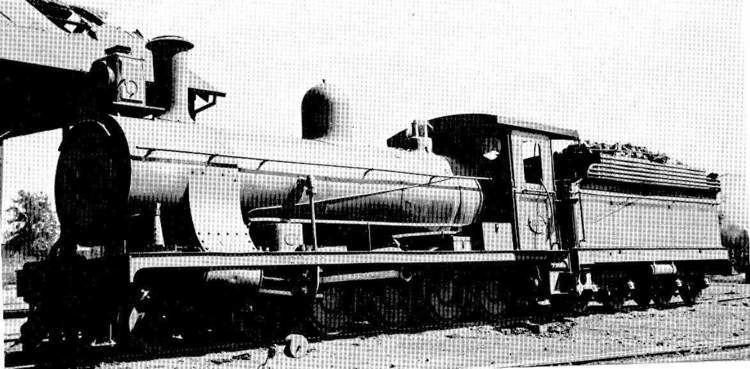Power type Steam | ||
 | ||
Builder Neilson, Reid and CompanyKitson and CompanyNorth British Locomotive Company Order number NR E834 & E835 (1899), E851 (1900)NBL L313 & L322 (1903) Serial number NR 5675-5686, 5791-5802, 5817Kitson 4062-4069NBL 16085-16094, 16171-16180 | ||
The South African Railways Class 7D 4-8-0 of 1915 was a steam locomotive.
Contents
- Rhodesian 7th Class
- Manufacturers
- South African Railways
- Classification errors
- Class 7 sub classes
- Modifications
- South Africa
- South West Africa
- Works numbers
- References
Between 1899 and 1903, the Rhodesia Railways placed 52 Cape 7th Class 4-8-0 Mastodon steam locomotives in service. During the Second Boer War, one more was obtained from the Imperial Military Railways in March 1901, as replacement for a locomotive which was damaged beyond local repair capabilities as a result of hostilities during delivery.
In May 1915, five of these locomotives were sold to the South African Railways, where they were renumbered and reclassified, four of them to Class 7D and the remaining one erroneously to Class 7B. At the same time, the ex Imperial Military Railways locomotive was also sold back to South Africa and was, also erroneously, designated Class 7D.
Rhodesian 7th Class
The original Cape 7th Class locomotive had been designed in 1892 by H.M. Beatty, at the time the Cape Government Railways Western System Locomotive Superintendent.
Between 1899 and 1903, 52 such Cape 7th Class 4-8-0 steam locomotives were built for the Beira and Mashonaland and Rhodesia Railways (BMR), later the Rhodesia Railways (RR). These locomotives were acquired by Southern Rhodesia at the time when railways were still expanding from South Africa via the Bechuanaland Protectorate into Southern Rhodesia in the southwest, and from Beira in Mozambique to Umtali in the east, and while the Second Boer War was in progress. At the time, the system was composed of several smaller railways, still largely under construction, which were eventually all linked up in 1902. These were:
Manufacturers
The 52 locomotives were ordered in five batches from three British manufacturers.
South African Railways
In May 1915, six of the Neilson, Reid-built 7th Class locomotives were purchased by the South African Railways (SAR) to augment its locomotive stock, which was being taxed severely due to war conditions at the time. These six locomotives included the war-damaged no. RR8 which had still not been repaired and consequently never ran a mile in revenue service in Rhodesia, as well as the ex IMR locomotive which had been transferred to Rhodesia as compensation for the damaged no. RR8.
These locomotives were initially referred to as Class RR, until they were later designated SAR Class 7D. Five of them were renumbered in the range from 1351 to 1355 on the SAR roster. The sixth, SAR no. 949, was erroneously designated Class 7B.
Classification errors
During this SAR classification and renumbering process, two of these locomotives were incorrectly classified, possibly as a result of their records getting exchanged in an apparent administrative error.
Class 7 sub-classes
Other 7th Class locomotives which came onto the SAR roster from the other Colonial railways in the region in 1912, namely the CGR, CSAR, the Natal Government Railways (NGR) and, in 1925, from the New Cape Central Railways (NCCR), were grouped into six different sub-classes by the SAR, becoming SAR Classes 7, 7A to 7C, 7E and 7F.
Modifications
During the 1930s, many of the Class 7 family of locomotives were equipped with superheating and piston valves. On the Class 7B and Class 7C, this conversion was sometimes indicated with an "S" suffix to the class letter on the locomotive number plates, but on the rest of the Class 7 family this distinction was not applied consistently. The superheated versions could be identified by the position of the chimney on the smokebox, the chimney having been displaced forward to provide space behind it in the smokebox for the superheater header.
South Africa
In SAR service, the Class 7 series worked on every system in the country. They remained in branch line service until they were finally withdrawn in 1972.
South West Africa
In 1915, shortly after the outbreak of the First World War, the German South West Africa colony was occupied by the Union Defence Forces. Since a large part of the territory's railway infrastructure and rolling stock was destroyed or damaged by retreating German forces, an urgent need arose for locomotives for use on the Cape gauge lines in that territory. In 1917, numbers 1351 to 1353 were transferred to the Defence Department for service in South West Africa.
These three locomotives remained in South West Africa after the war. The Class 7s proved to be so successful in that territory that more were gradually transferred there in later years. By the time the Class 24 locomotives arrived in SWA in 1949, 53 locomotives of the Class 7 family were still in use there. Most remained there and were only transferred back to South Africa when the Class 32-000 diesel-electric locomotives replaced them in 1961.
Works numbers
Their builders, works numbers and renumbering are listed in the table.
